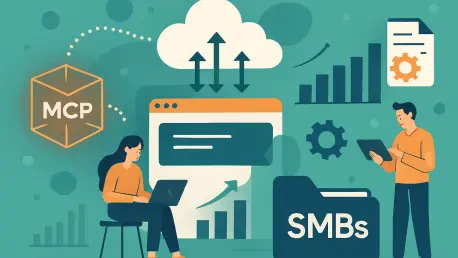In today’s fast-paced business environment, small to medium-sized businesses (SMBs) face mounting pressure to streamline operations while keeping costs in check, especially when managing disparate data systems that often operate in silos. Recent research highlights a stark reality: 65% of data-driven SMBs are already outperforming their competitors, leaving those slower to adopt modern solutions struggling to keep up as the performance gap widens every quarter. The challenge lies in transforming fragmented data workflows into a cohesive, efficient system without breaking the bank or requiring extensive technical expertise. Fortunately, advancements like the Model Context Protocol (MCP) paired with no-code automation tools offer a lifeline. This approach can slash data preparation time and IT expenses by half, connecting critical systems like CRM, ERP, and analytics into a single, secure stream. By exploring how MCP simplifies complex integrations, SMBs can uncover immediate savings in time, labor, and missed opportunities, positioning themselves among industry leaders without writing a single line of code.
1. Unpacking the Data Challenges for SMBs
The reality for many SMBs is a tangle of isolated systems that stifle growth and drain resources through inefficient, manual processes. Sales teams often waste hours copying Shopify orders into accounting software, while marketing staff struggle with exporting CSV files to sync email lists across platforms like Mailchimp and HubSpot. Finance departments are not spared either, as they manually reconcile inventory data, sometimes spending 15 staff hours weekly just to align counts with ledgers. These swivel-chair operations not only consume valuable time but also increase the risk of errors—a single misplaced SKU can skew margin forecasts or trigger audit concerns. The result is a data stack that lags behind business needs, delaying critical tasks like month-end closings and obscuring real-time performance metrics. For SMBs without the budget for dedicated IT teams, the choice often boils down to overworking staff or accepting blind spots in their operations, both of which hinder competitiveness in a data-driven market.
Legacy systems exacerbate these struggles, creating additional barriers to efficiency for SMBs trying to modernize. On-premise ERP solutions frequently fail to communicate with cloud-based storefronts, while outdated scripts or macros break down when vendors update their APIs. This brittleness leaves businesses vulnerable to disruptions, as even minor changes can halt workflows. Without the resources to build custom integration solutions, many SMBs are stuck with rigid setups that strain cash flow and limit agility. The lack of real-time data connectivity means leadership often navigates through uncertainty, unable to make informed decisions quickly. Addressing this dilemma requires a shift toward automation that is both accessible and scalable, allowing SMBs to break free from manual drudgery and focus on strategic growth. Tools that simplify integration without demanding coding skills or hefty investments are essential to leveling the playing field.
2. Exploring the Role of Model Context Protocol (MCP)
At the heart of modern data automation lies the Model Context Protocol (MCP), a groundbreaking standard that functions much like a universal adapter for AI-driven systems. Comparable to USB-C in hardware, MCP enables any compliant model to seamlessly recognize, request, and process data from other systems without the need for custom-coded bridges between every application. By publishing a lightweight descriptor, developers allow tools to self-describe their functions, parameters, and access rules, ensuring instant interoperability. Built on pillars like universal connectivity through JSON-RPC 2.0, structured context for precise data interactions, and local-first security to protect sensitive information, MCP transforms data silos into callable services. Since its open-sourcing by Anthropic in late 2024, major platforms like Zapier, OpenAI, and Google DeepMind have adopted it, establishing MCP as a cornerstone for AI workflows in production environments.
The significance of MCP for SMBs cannot be overstated, as it eliminates the combinatorial nightmare of coding unique integrations for every model and application pairing. Its structured context categorizes interactions into executable functions, streamed data, or reusable instruction templates, delivering only the necessary information to models in the correct format. Meanwhile, its security framework ensures that calls execute on the user’s device by default, requiring explicit human approval for new capabilities, thus safeguarding personal and financial data. This design empowers SMBs to integrate systems swiftly and securely without needing deep technical expertise. As adoption continues to grow, MCP stands as a lingua franca for automation, enabling businesses to focus on leveraging data rather than wrestling with connectivity issues. This protocol paves the way for a future where integration is no longer a barrier but a competitive advantage.
3. Why Automation Is a Game-Changer for Data Integration
Automating data integration offers SMBs a transformative path to reclaim lost time and drive operational efficiency. Manual hand-offs, such as exporting, cleansing, and rekeying data, often consume 10 to 20 hours weekly for staff, time that could be spent on higher-value tasks. Automation streamlines these ETL (extract, transform, load) processes, running them on autopilot to free up significant labor. Beyond time savings, it cuts costs by reducing human error—a mere 2% error rate on invoices can wipe out profit margins, but automated systems minimize such risks while trimming labor expenses. The financial impact is clear: a retailer saving 15 hours weekly at $35 per hour can save over $27,000 annually. Redirecting those hours into revenue-generating activities like prospecting could further boost top-line growth by thousands, illustrating the dual benefit of cost reduction and opportunity capture.
Scalability and customer insights further underscore the value of automated data integration for SMBs. Workflows that once faltered at handling 5,000 data rows can now manage 5 million without breaking, while new applications can be added through drag-and-drop connectors instead of hiring additional staff. This scalability ensures businesses can grow without being bogged down by data bottlenecks. Additionally, unified data records enable AI to deliver real-time insights, such as identifying churn risks or cross-sell opportunities while customer interactions are still active. These advantages compound to directly lower the data management costs that many SMBs struggle to control. By automating integration, businesses not only enhance efficiency but also position themselves to respond faster to market demands and customer needs, gaining a critical edge over competitors still mired in manual processes.
4. Harnessing MCP with No-Code and Low-Code Tools
The synergy between MCP and no-code or low-code tools creates a powerful engine for SMB data automation, bridging the gap between scattered data and actionable AI. Platforms like Zapier and Skyvia allow businesses to integrate disparate streams—such as orders, invoices, and support tickets—into a unified flow using simple drag-and-drop interfaces. With MCP, every fresh data record becomes a typed resource or callable tool, instantly visible to AI models. For instance, a new deal valued at $4,237 with a payment due in 14 days can be recognized and acted upon without manual input. This seamless connectivity eliminates the traditional separation between data storage and AI processing, ensuring information flows in real time across systems. SMBs can thus maintain a competitive pace without investing in complex, custom-coded solutions.
Beyond integration, the combination of MCP and low-code tools enables automated actions that drive efficiency to new heights. Once data is unified, AI can leverage MCP-defined tools to perform tasks like updating CRM opportunities, generating invoices, or sending customer emails—all without additional coding or human oversight. This closed-loop execution means transactions are posted instantly, follow-ups reach customers before competitors react, and staff can focus on exceptions rather than repetitive busywork. The result is a dramatic reduction in operational delays and an increase in responsiveness. For SMBs, this duo offers a practical way to transform data from a burden into a strategic asset, allowing teams to prioritize customer engagement and growth initiatives over mundane data handling tasks.
5. Real-World Impact: A Retail Integration Success Story
A compelling example of MCP-driven automation in action can be seen in the experience of Redmond Inc., an outdoor brands group processing 1,000 to 3,000 Shopify orders daily while managing back-office operations on Acumatica. Previously, the company relied on manual CSV file transfers to sync order and inventory data, a process that consumed significant time and introduced errors. By implementing a no-code pipeline through a platform like Skyvia, Redmond Inc. automated the replication of every order and stock update into a SQL Server staging area and onward to Acumatica. This eliminated the need for scripts or manual data juggling, streamlining the entire workflow. The shift to automation not only improved data accuracy but also freed up staff to focus on more strategic priorities, demonstrating how accessible tools can deliver enterprise-level efficiency to SMBs.
The financial and operational benefits for Redmond Inc. were substantial, underscoring the potential of MCP-enabled solutions for other SMBs. The automation project negated the need for a planned custom build with Azure Logic Apps, saving over $60,000 annually in licensing, development time, and transaction fees. Additionally, near-real-time inventory visibility empowered customer service reps to address inquiries more effectively, significantly reducing “where’s my order?” tickets. Stock-out surprises became a thing of the past, enhancing customer satisfaction and operational reliability. This case highlights how integrating MCP with no-code tools can transform data challenges into measurable gains, offering a blueprint for SMBs looking to optimize high-volume workflows without straining budgets or requiring specialized IT skills.
6. Step-by-Step Guide to Deploying Automation Tools
Implementing data automation for SMBs using MCP and no-code tools can be achieved through a structured, five-step approach that minimizes risk and maximizes impact. First, identify efficiency drains by cataloging all manual data tasks—such as file exports or duplicate entries—and prioritize the top two based on time lost and revenue impact. Second, clean up data foundations by standardizing customer, product, and financial schemas, removing duplicates, enforcing consistent formats for dates and currencies, appointing a data overseer, and scheduling nightly quality checks. Third, test a key process like inventory-to-general-ledger sync by setting up a tool like Zapier in a sandbox environment, mapping the process, establishing a fallback option, and targeting less than a 1% error rate at launch. These initial steps ensure a solid base for automation without overwhelming existing systems or staff.
Continuing the deployment process, the fourth step involves integrating MCP-powered AI by making cleaned data available as resources, defining update and notification functions as tools, and granting AI minimal access rights to automate tasks like invoicing or CRM updates. Finally, evaluate, adjust, and expand by measuring improvements in speed, accuracy, and labor hours before and after implementation, fine-tuning settings, broadening data fields, and applying the solution to the next workflow bottleneck. This iterative approach compounds efficiency gains with each cycle. By following these steps, SMBs can systematically transition from manual data handling to a streamlined, automated ecosystem. The focus remains on starting small, validating results, and scaling success, ensuring that automation delivers tangible value without introducing unnecessary complexity or disruption to daily operations.
7. Navigating Common Automation Pitfalls
While automation offers immense benefits, SMBs must be vigilant about potential challenges that can undermine success, starting with the issue of dirty data. Without proper governance, automated systems can propagate inaccurate records at an accelerated pace, amplifying errors across workflows. To mitigate this, establish a weekly data quality review assessing completeness, uniqueness, and accuracy, and halt workflows that fall below set standards. Additionally, poor data inputs can cripple even the most sophisticated tools, leading to unreliable outputs that erode trust in automation. Proactive measures, such as appointing a data steward and enforcing validation rules, are critical to maintaining integrity. By prioritizing data cleanliness from the outset, businesses can ensure that automation enhances rather than hinders decision-making processes.
Security risks and automation sprawl present further hurdles that SMBs must address to sustain effective data integration. Every new connector widens the attack surface, making it essential to use minimal-access API keys, rotate passwords quarterly, encrypt data during transfer and storage, and mandate multi-factor authentication for production changes. Meanwhile, when multiple teams create independent automation workflows, visibility can erode, leading to redundancy or conflicts. To counter this, designate an automation coordinator, maintain a centralized log of all flows, link each to a specific business goal, and eliminate underperforming setups. These strategies help maintain control and security while scaling automation efforts. By anticipating and addressing these pitfalls, SMBs can build a robust foundation for data integration that supports long-term growth and resilience.
8. Transforming Data into Growth Opportunities
Reflecting on the journey of SMBs grappling with data integration, it’s evident that disconnected systems once drained significant time, money, and clarity from operations. The adoption of no-code and low-code tools, combined with the innovative Model Context Protocol, turned fragmented data into a dynamic, secure system that enhanced billing accuracy, accelerated sales cycles, and improved executive visibility. This powerful combination addressed critical pain points, allowing businesses to shift focus from manual tasks to strategic priorities. Looking back, the transition to automation proved to be a pivotal move for many SMBs, enabling them to compete more effectively in a data-driven landscape and laying the groundwork for sustained success.
To build on past achievements, SMBs should take actionable steps to further harness automation’s potential. Starting with a free trial of an MCP-enabled platform like Zapier, which offers 300 tool calls at no cost, is a low-risk entry point. Conducting a focused two-day data cleanup to deduplicate records and standardize keys can set a strong foundation. Accessing vendor resources for pricing and security details from platforms like Skyvia and Integrate.io provides additional guidance. Automating a single critical workflow, measuring the resulting gains, and reinvesting those savings into the next use case ensures continuous improvement. These steps empower SMBs to convert data challenges into fuel for growth, maintaining momentum in an increasingly competitive market.









